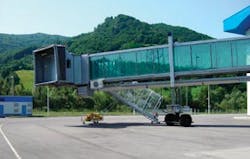Twenty years ago, there wasn’t a lot of emphasis on passenger boarding bridge technology and design. Fast forward twenty years later, and that thought process has changed … considerably. Not only do customers demand a bridge that will last longer and service a wider range of aircraft, but they want a design that is both easy to maintain and aesthetically pleasing to the surrounding airport environment.
Technology & Design
Over the years, airlines and airports have been forced to change their aircraft mix to include regional jets in smaller markets. To meet this new demand, bridge manufactures have been able to adapt their apron drive specifications to include hinged floors, floor cutouts and extension planks. Most regional airports are ground level, so the introduction of Lows-Rider bridges with small wheels, or radial bridges, have been a solution. But airlines aren’t just focused on regional jets; they’re also going to the opposite extreme with larger aircraft. The introduction of the new A380 has bridge manufactures creating new types of bridges, with long stroke lift columns, to meet the height requirements of these mammoth aircraft, while still serving the existing mix of aircraft. Having to reach the upper decks, and even doors behind the wings, has been a challenging, but rewarding, example of engineering mastery.
Providing customers with more bridge options gives them added flexibility. Bag slides, lifts, and bag chutes are becoming more important with regional jet applications. The integration of 400 Hz and PCA directly to the bridge makes it more productive and cost effective for the owner. Hydraulic lift systems enable the bridge to operate under extreme environmental conditions with lower maintenance costs and repairs than other lift systems.
Today’s airport terminal design puts a lot of demand on bridge functionality as well as aesthetics. So once again, bridge manufactures have met the challenge of creating a “Crystal”, or glass, bridge that can meet all mandated requirements, such as NFPA glass. These new designs enable bridge customers to add an artistic extension to their terminal. The traveling public around the world is embracing these new designs, and it’s a matter of time before we begin to see more glass bridges being specified at U.S. airports.
Twenty years ago, the useful life expectancy of a bridge was 10 years based on customer’s specifications. But customers are demanding longer use out of their bridges. The good news is that life expectancy is now pushing over 20 years. This is due to better engineering, manufacturing, and maintenance. These factors have also enabled the total cost of bridge ownership to go down over the years.
Passenger Boarding Bridges are becoming more technologically advanced, and their design is more efficient than ever before. As changes in the industry occur with new airports and more advanced aircraft, bridge manufacturers are ready to meet the demand and challenges that will be required in the future.





